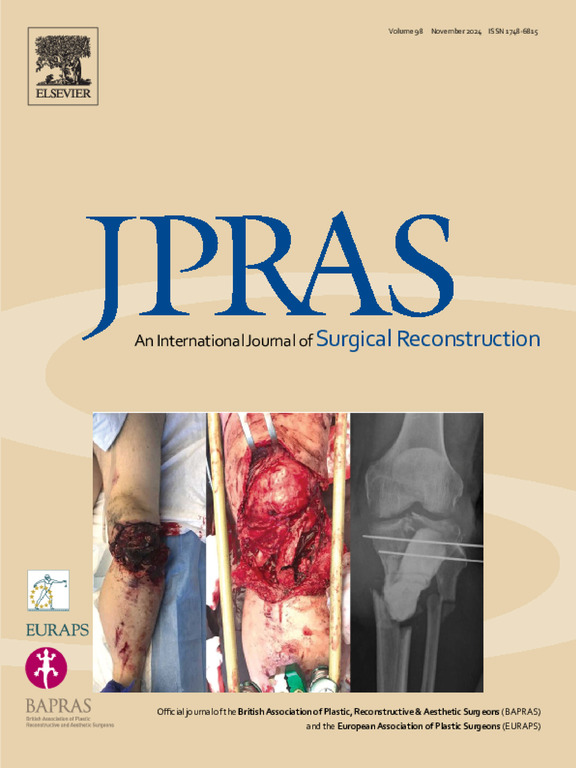Impact of post-bariatric lipoabdominoplasty on knee and hip function: A biomechanical and symptomatic analysis
IF 2.4
3区 医学
Q2 SURGERY
Journal of Plastic Reconstructive and Aesthetic Surgery
Pub Date : 2025-08-29
DOI:10.1016/j.bjps.2025.08.027
引用次数: 0
Abstract
Massive weight loss after bariatric surgery frequently results in redundant abdominal skin that can compromise posture, gait, and joint biomechanics. This prospective study investigated the functional effects of circumferential lipoabdominoplasty in post-bariatric patients. Eighteen individuals (mean BMI 29.3 kg/m²), all weight-stable for at least 12 months, underwent 360° lipoabdominoplasty with removal of ≥4 kg of tissue. Hip and knee range of motion (ROM) was measured preoperatively, at 1 month, and at 12 months postoperatively. Patient-reported outcomes were assessed using the BODY-Q Physical Symptoms (PS) and Physical Function (PF) domains. At 12 months, mean hip flexion improved from 110° ± 8° to 120° ± 7°, and knee flexion from 130° ± 10° to 140° ± 9° (p < 0.05). PS scores increased from 58 ± 10 to 80 ± 9, and PF from 60 ± 11 to 79 ± 8 (p < 0.05). No significant correlation was observed between ROM gains and BODY-Q scores, suggesting that improvements are mediated by mechanical release, postural realignment, and psychosocial benefits rather than mobility alone. These findings indicate that lipoabdominoplasty, while traditionally performed for aesthetic purposes, may play a significant role in enhancing functional recovery and quality of life following massive weight loss.
减肥后脂肪腹部成形术对膝关节和髋关节功能的影响:生物力学和症状分析
减肥手术后大量减重通常会导致多余的腹部皮肤,从而损害姿势、步态和关节生物力学。这项前瞻性研究调查了围周脂肪腹部成形术对减肥后患者的功能影响。18例患者(平均BMI为29.3 kg/m²),体重稳定至少12个月,接受360°腹部脂肪成形术,切除≥4kg组织。术前、术后1个月和12个月分别测量髋关节和膝关节活动度(ROM)。使用BODY-Q身体症状(PS)和身体功能(PF)域评估患者报告的结果。12个月时,平均髋屈曲度从110°±8°改善到120°±7°,膝关节屈曲度从130°±10°改善到140°±9°(p < 0.05)。PS评分从58±10分提高到80±9分,PF评分从60±11分提高到79±8分(p < 0.05)。ROM增加和BODY-Q评分之间没有明显的相关性,这表明改善是由机械释放、姿势调整和心理社会益处介导的,而不仅仅是活动能力。这些研究结果表明,虽然传统上是为了美观而进行的,但脂肪腹部成形术可能在大幅减肥后的功能恢复和生活质量方面发挥重要作用。
本文章由计算机程序翻译,如有差异,请以英文原文为准。
求助全文
约1分钟内获得全文
求助全文
来源期刊
CiteScore
3.10
自引率
11.10%
发文量
578
审稿时长
3.5 months
期刊介绍:
JPRAS An International Journal of Surgical Reconstruction is one of the world''s leading international journals, covering all the reconstructive and aesthetic aspects of plastic surgery.
The journal presents the latest surgical procedures with audit and outcome studies of new and established techniques in plastic surgery including: cleft lip and palate and other heads and neck surgery, hand surgery, lower limb trauma, burns, skin cancer, breast surgery and aesthetic surgery.

 求助内容:
求助内容: 应助结果提醒方式:
应助结果提醒方式:


